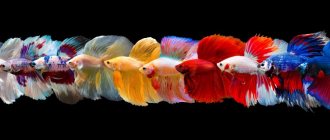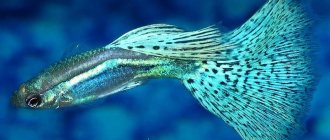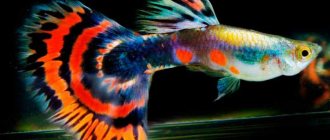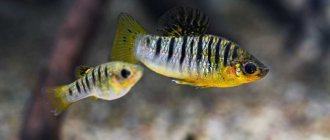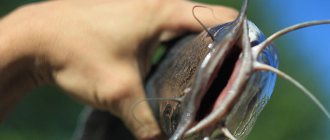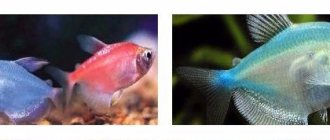Guppy fish are one of the most famous species among aquarium fish. They are very easy to care for. They will please the eye and lift your spirits.
In this article we will look at everything about guppies: history; habitat; life expectancy; about care; feeding; sexual differences; species names; compatibility with other fish; reproduction; diseases, their symptoms and treatment. The information will be useful to those people who are planning to keep this beautiful type of aquarium fish.
Appearance and description
Guppies belong to the poeciliaceae family. These aquarium fish are small in size. On average, their body length ranges from 2 to 7 cm. Wild guppies are smaller than varieties that have pronounced selection characteristics. Females of this species are much larger than males. This is not the only sign by which you can understand how to distinguish a female and a male.
The shape of the caudal fin and the color of the fish depend on its variety. A feature of all guppies is the ability to give birth to viviparity. This is a kind of adaptation to life in bodies of water, where many predators live that can eat eggs left unattended.
Distribution and habitats
Guppy fish are quite common in nature, so they quickly adapt to environmental conditions.
The world learned about guppies (Poecilia reticulata) in the second half of the 19th century. This species was first described during the study of the aquatic fauna of the Amazon. In fact, these creatures have chosen almost all freshwater and brackish water bodies located in Guiana and Venezuela. They are found in lakes and ponds in northern Brazil. Large populations of guppies have been identified in the waters of the islands of Trinidad and Barbados.
To maintain the population, fish need clean running water and sufficient food supply. In nature, these creatures eat:
- small insects;
- worms;
- bloodworm;
- larvae, etc.
At the beginning of the 20th century, these creatures began to be resettled in the waters of Africa, because... juvenile fish effectively fought against malaria mosquito larvae. Under natural conditions, guppies rarely grow to large sizes, as they often become food for predators.
A small population of guppies lives in the Moscow River in hot water discharge areas in Lyubertsy. These are aquarium fish, guppies, which were once released by amateur aquarists and subsequently went wild, adapting to changing conditions. Although these creatures prefer warm waters, they can survive the drop in temperature during the winter. In other cities of Russia and the world, the appearance of small populations of guppies is also noted in areas where warm waters are discharged into rivers and septic tanks.
Interesting Facts
Cheerful, brightly colored fish not only decorate home ponds.
Few people know that:
- a female Endler's guppy is able to retain the sperm of a male in her body for about three months, and accordingly, she can give birth to fry without a male several times, and she can easily do this even in a glass of water;
- each male guppy has a unique coloring that is not repeated twice;
- the guppy was the first fish to travel into space on board the Salyut 5 orbital station;
- It’s hard to believe, but in the 19th century, wild guppies saved the local population from the spread of malaria by eating eggs, larvae and pupae of malaria mosquitoes;
- These miniature fish are also tested for the degree of wastewater treatment, the effects of chemicals and heavy metals.
The reason for the popularity of guppies
The main reason for the popularity of these creatures is their unpretentiousness. Since even novice aquarists can keep guppies, fish are often recommended for those who decide to create an artificial aquatic environment at home.
Gupeshki are often found in living corners of kindergartens and schools. Since caring for guppies is not difficult, even small children can be trusted to do this. The ordinary guppy is unpretentious. Food for it is sold at any pet store.
In addition, you can easily select neighbors, decorations and aquatic plants for your fish. Simple aquarium fish, guppy poecilia reticulata, can easily survive even some violations of the maintenance rules. However, relatively recently bred varieties are characterized by low immunity and a tendency to various infectious and parasitic diseases.
Caring for guppies is also interesting for experienced breeders. The high reproduction rate provides an opportunity for selection. Breeding species is a fascinating activity. Artificially produced breeds of guppies require special attention and special conditions. Breeding such fish is somewhat difficult. To achieve offspring from individuals obtained during the selection process, you need to choose the right partners and create optimal conditions for them.
Types of guppies
In addition to the natural varieties of these fish, many types of guppies have been obtained through the process of selection. All of them were bred under artificial conditions. They are conventionally divided into 13 breeding forms, classified according to different parameters. Depending on what the fish's tail looks like, the following types of guppies are distinguished:
- round-tailed;
- spinytails;
- flagtails;
- spadetails;
- lyrebirds;
- spear-tailed.
The fin length of these beautiful fish varies from 0.5 to 3 cm. The shape of the sword is upper, lower and double. Some fish species have a narrow fin, while others have a tail that resembles a veil. In addition, it can be fan-shaped or acute-angled.
Depending on the nature of their color, guppies are divided into 8 groups. They include albinos, plain blue-black, green, blue, fiery red, black and white, spotted, iridescent fish, etc. Breeds that are very popular include:
- tomato;
- Red clove;
- red multicolor carnation;
- red cobra;
- Moscow scarlet;
- orange filigree;
- orange carpet;
- yellow carpet;
- golden;
- Moscow blue-green;
- green cobra;
- blue carpet;
- Moscow blue;
- black Prince;
- black monk;
- half-black prince;
- pearlescent white;
- endler leopard;
- leopard cobra;
- blue neon;
- green neon;
- purple neon;
- red neon;
- albino;
- Berlin;
- Berlin gold;
- yellow;
- blond;
- Savage;
- Spanish;
- Canadian;
- multicolor;
- smaragdine;
- Tuxedo;
- glass;
- panda.
The most common breed found in people's aquariums is the tomato. The coloring of the guppy is uneven. The wide caudal fin, like the dorsal fin, is distinguished by a rich red color. The scales on the back and top of the head are the same shade. The pelvic fins of representatives of this breed are transparent. The scales on the sides and abdomen are silvery.
The red carnation guppy has large red fins. The body and head of the fish are rich red. White spots may be present on the head near the gills. This type of fish is small in size. Males rarely grow more than 3 cm.
The red multicolored carnation is characterized by the presence of a striking blue-orange mottled caudal fin. At the base of the tail the scales are dark blue, and on the head, sides and abdomen they are silver. Individual scales on the back and head glow neon blue. There are bright orange spots on the body of the fish.
The red cobra guppy is brightly colored. The orange-red background features a black filigree pattern that resembles snakeskin. This breed is characterized by a wide fan-shaped tail and a large back fin. The color of the head and abdomen is lighter.
Male Moscow scarlet guppies are distinguished by their red body and fins. The tail is a darker shade. The head is milky white. Females of this species have a white-transparent abdomen and fin, and a bright red caudal fin.
The orange filigree guppy has bright orange-red fins. There is a black speckled pattern on the fins and body of the fish. These guppies have a large fan-shaped tail fin. The dorsal fin is large.
The orange carpet guppy is distinguished by its large tail and dorsal fins. These parts of the fish's body are bright orange-yellow in color with a mosaic spotted pattern. The scales on the body are bluish-black, and on the head they are silvery. Males are more colorful than females.
The golden fish has a noble yellow color on its scales and the central part of the caudal fin. The ventral and dorsal fins are white with a metallic tint. The edge of the tail of this fish is white. Females reach 4.5 cm, and males - 3 cm.
The yellow carpet guppy has a yellow tail with a speckled black pattern. The base of the tail is gray. The back and sides are decorated with a yellow-gray striped and speckled pattern. The pectoral and ventral fins are transparent.
Moscow blue-green guppies have large dorsal and caudal fins. The fish shimmers with green and blue colors. The scales reflect light well, which enhances the overall effect. The tips of the caudal and dorsal fins have dark edging.
Green cobras are distinguished by their spotted yellow-green color. It is slightly darker on the back and lighter on the belly. The fish have a spotted black and yellow pattern on their fins. Representatives of this species reach 3 cm in length.
There are many other common species of these representatives of aquatic fauna, differing in body size and color of fin scales.
How to distinguish a male from a female?
You can determine the sex of a guppy by its color. Males are distinguished by bright colors. Females are duller. Often the color of their scales is monochromatic or even gray. In females, a maternity spot stands out on the abdomen. Since it is not difficult to determine the sex of a guppy, breeders pay attention to this parameter when purchasing. However, this is not the last difference.
Females have a more rounded body shape and relatively small fins. In males, the body is slightly elongated and slightly flattened laterally. The fins of males are larger than those of females. Bright colors and large fins make males more attractive to females. This allows you to quickly determine the sex of the guppy.
Even the young age of the guppies does not interfere with sex determination. Males acquire the color characteristic of adults earlier than females. For breeding in home aquariums there is no need to have a large number of males. In most cases, one male is enough to fertilize 5-6 females. It is not necessary to remove beautiful males from the aquarium, since they do not fight with each other even during the breeding season. However, after birth, the offspring must be separated, since the fry will become easy prey for adults.
How to determine the sex of a goldfish?
Males develop tubercles or white tubercles, growths along the pectoral fins and gill covers. In addition, the male develops jagged teeth on the paired front fins, the so-called “saw”. Females become slightly asymmetrical, especially in the abdominal area. They look bloated.
Interesting materials:
Where can I get a personal income tax certificate 2 for a bank? How quickly do you pay taxes through Sberbank Online? How often does the Bank's Bic change? How often can you take out a loan from Sberbank? How to pay for Revo through Sberbank Online? How do you get a loan from Sberbank online? How to disinfect jars? How long does it take for the bank to approve a loan? How long does it take to pay taxes through Sberbank? How long does it take for a transfer to a Sberbank account to take place?
Requirements for an aquarium
When it comes to such guppy fish, keeping and creating the necessary conditions for them requires taking into account the species of the purchased creatures. These fish are small in size, so a 3 liter container will be enough for them. However, if you wish, you can purchase a larger aquarium. It is recommended to use a spacious aquarium that can hold up to 40 cm of water.
If you plan to keep guppies in an aquarium together with aquatic plants and other fish, it is better to immediately acquire a 35-50 liter aquarium. In addition, it must be taken into account that these fish need to regularly replenish their swim bladder. Thus, it is necessary that at least 3 cm of air remain between the lid and the surface of the water.
Guppy fish are viviparous, so when waiting for the fry to appear, it is recommended to immediately reduce the water level. It should be no more than 20 cm. This will allow the fry to quickly rise to the surface after birth to fill their swim bladder. A few days after the fry are born, the water level can be increased.
It is recommended to plant aquatic plants in the aquarium. The Indian fern shows itself well. It acts as a kind of indicator of the well-being of the fish’s habitat. If this plant has taken root well and is growing, everything is fine. If the roots begin to rot or the fern has died, it means that there is a lot of ammonia in the water and measures must be taken to protect the fish from death.
Small-leaved plants can be planted in the aquarium. Decorative stones are allowed for decoration. It is better to use washed river sand, cleaned shells and small pebbles as soil.
The recommended daylight hours are 9-10 hours. It is desirable that sunlight falls on the walls of the aquarium. This will extend the life of the guppy. At the same time, in the summer you need to make sure that the temperature of the water in the aquarium does not rise too much. Constant lighting negatively affects the condition of these creatures. In addition, it often leads to algae blooms.
For additional lighting, it is better to use a 15 W fluorescent lamp in summer and 25 W in winter. The lamp should be placed in the center of the aquarium. To ensure good conditions for keeping guppies, the aquarium is equipped with an aeration and filtration system.
Birth of fry
So, the “kindergarten” for children is ready. For childbirth, the female needs to create optimal conditions: the water temperature should be 26 - 28 degrees (in the first two weeks), aeration and lighting should be maintained constantly.
Guppies are viviparous fish. The babies are born and immediately rush to the bottom or into the thickets of vegetation. The instinct of self-preservation forces them to do this. Otherwise, the Guppy fry risk being eaten by their own mother. Maternal instinct is not inherent in this species of fish.
A primiparous female can give birth to at least 20 fry. In the future, their number can reach 180 pieces. Although newborns are only 3 – 5 mm in size, caring for baby guppies is very easy.
If everything happened as expected, the birth was not premature, and the babies should not have a visible yolk sac. If it is present, then the fish were born too early and will not be viable.
Water requirements
Guppies are not too picky about the composition of the water. It is enough to pass the liquid through the filter and then let it sit for 2 days. Recommended water hardness ranges from 12.0 to 18.0 gh. The acidity should be 7-8 pH. However, even if these parameters are not met, this will not lead to the death of the fish. The water temperature in the aquarium for guppy fish should be +23...+26°C. This is the optimal temperature in the aquarium for guppies, at which these creatures will develop normally and remain healthy.
Elevated water temperatures are dangerous for guppies. In this case, the fish develop faster, which negatively affects their life expectancy. In such conditions, the risk of developing infectious diseases is increased. A decrease in temperature to +18…+ 22°C leads to a slowdown in fish growth. In such conditions they grow to larger sizes. At the same time, a decrease in temperature to +17°C causes an increase in diseases. Daily fluctuations within 3-5°C cannot harm these fish.
How long guppies live in an aquarium largely depends on the frequency of water changes. Some breeders recommend changing 30% of the water in the aquarium at least 4 times a month. Part of the water that will be used for replacement must be pre-settled.
It is believed that gradual replacement is more beneficial for these fish. With this approach, change 1-2 liters of water every day. Replacing a large volume is fraught with a sharp change in the chemical composition and temperature in the aquarium, which will negatively affect the fish. Females can become infertile due to stress, and males often begin to split their fins.
Reproduction
Endlers reproduce well in a community aquarium, provided that ordinary guppies do not live next to them. To maintain the purity of both breeds, reproduction occurs in a spawning tank.
Favorable conditions
If the common reservoir has good filtration, aeration and a lot of plants, future parents will not need human help.
To create favorable conditions for a pregnant fish, you need a little:
- Correctly determine the gestational age and readiness of the fish for childbirth.
- Set up a fish tank in advance and transplant the expectant mother into it.
- Do not disturb the pet just before birth.
Features (write about live birth)
The Endler female, like all livebearers, is capable of producing offspring already prepared for independent life with a frequency of 22-24 days. Unlike other fish, mother guppy rarely eats her children. but this can happen. Therefore, when the birth process is over, the female is transplanted into a common aquarium.
Determination of gestational age
Beginning aquarists need to learn how to determine the stage of pregnancy and readiness for childbirth. The accuracy should be maximum - 1-2 days.
Signs of pregnancy to look out for:
- A dark spot appears in the back of the abdomen (next to the anal fin).
- In most species of guppies, the abdomen of the pregnant female becomes almost square.
- Swelling near the anus is the main sign of impending labor.
This is done in order to place the female in advance in a prepared spawning tank so that she gets used to the new environment and does not experience stress. Only in this case will the offspring be born healthy and active.
Below is a photo of a guppy in the last stage of pregnancy.
Preparing the depositor
Childbirth is an important process that requires the attention of the fish farmer. Therefore, the arrangement of the sedimentation tank must be taken responsibly.
The requirements are as follows:
- The volume of the aquarium is 12-30 liters.
- No soil required. This is important for maintaining cleanliness.
- The internal filter and compressor must operate around the clock.
- There should be no strong current in the reservoir.
- The presence of plants and moss is mandatory for the comfort of children.
The container is prepared in advance so that biological equilibrium is established.
Childbirth
When optimal conditions are created, the female produces up to 30 fry. If the female cannot give birth, labor is stimulated by placing a male next to the expectant mother, as well as increasing the temperature in the nursery by 2-3 ºС and adding fresh water to it.
Nursing babies
The fry that are born are quite large and can immediately feed on small dry food and Artemia nauplii. With regular meals three times a day, they grow quickly and at the age of one month the males are fully colored and ready to breed.
Care and maintenance of guppies
Guppies are easy to care for. It is necessary to monitor the behavior of the fish to understand what they are missing. If these aquatic creatures swim just below the surface of the water and grab bubbles, this indicates insufficient oxygen saturation in the environment. To avoid this, aerate the water at least 2 times a week. You should siphon the bottom and decorative elements in the aquarium at least 4 times a month.
To purify water, you can install an inexpensive filter with a sponge. Such a device will be enough to purify the water, but at the same time the fish will not be sucked in. To prevent a decrease in immunity in fish, you should add 2-3 drops of iodine and a solution of sea salt to the aquarium once every 6-8 weeks.
In addition, you need to take into account that these fish, like other representatives of aquarium fauna, can suffer from parasitic and bacterial infestations. To prevent infection, after purchasing the fish, you must keep them in a quarantine aquarium for at least 2 weeks and then release them into the main one.
Nutrition and diet
Guppies are omnivorous fish. It is permissible to introduce dry, live and frozen food into their diet. It is best to purchase dry flakes designed for tropical fish. Such formulations contain essential nutrients and various additives that improve the color of fish. Many breeders recommend periodically feeding live food. You can include in your diet:
- aquatic crustaceans;
- small shrimp;
- tubifex;
- mosquito larvae;
- bloodworms, etc.
In addition, guppies eat scalded lettuce and pea skins well. The feed must be thoroughly crushed, because... The mouth opening of these creatures is small.
Proper feeding
Overfeeding can cause fish death. It is better to feed the guppies 2-3 times a day, but in small portions. The best time for feeding is morning and evening. In addition, it is recommended to have a fasting day once a week.
Lifespan
How long aquarium fish live depends on their variety. Most species of guppies bred in artificial conditions live for about 8-10 months. The lifespan of fish close to those found in natural conditions reaches 3-5 years. How long guppies live in an aquarium depends on the conditions under which the creatures are kept.
How quickly they grow, what to feed and how to care for them
Guppies grow amazingly fast. Under proper housing and feeding conditions, after one and a half to two months the first males will begin to acquire a beautiful, bright color, and the first coal spots will appear.
At 3 months they are already fully formed and reach sexual maturity. The guppy's color improves and becomes clearer and more beautiful with age. The older the male, the more uniquely colored his fins and tail are.
First days
In the first days of life, the fish are already quite active. Immediately after birth, babies actively swim around the aquarium in search of food. In order for them to eat properly, it is necessary to give them only small food.
The ideal option would be brine shrimp and live sand. Sometimes you can dilute the diet with chopped boiled yolk from a chicken egg. Baby guppies eat yolk
Compatibility with other fish
Guppies are not known for their aggressive nature, so they cannot be housed with all types of fish. The best neighbors will be small, non-conflicting fish. Guppies can be kept together with:
- cockroach;
- corridors;
- neon;
- tetras;
- zebrafish;
- boots;
- iris;
- gourami;
- cockerels, etc.
Placing guppies with pangasius, gouramis and other large predatory species will result in the small representatives of the aquarium fauna being quickly eaten. Barbs and some other species can bite the large fins of males. In addition, it is unacceptable to combine guppies with aggressive cyclids.
Recommendations from experts
Inexperienced people planning to get into aquarium keeping are advised to start by keeping groups of guppies of the same species. To begin with, 10 individuals will be enough - 5 males and 5 females. The volume of the aquarium must be at least 50 liters.
It is best to temporarily isolate pregnant females from other fish. After the fry are born, the female should be placed back with her relatives.
It is advisable to keep the fry separately, since adult guppies often eat their offspring. If the fry were born in an aquarium with adult fish, it is necessary to take care of their shelter. It can be used as floating algae, which will form dense and lush thickets at the surface of the water.

